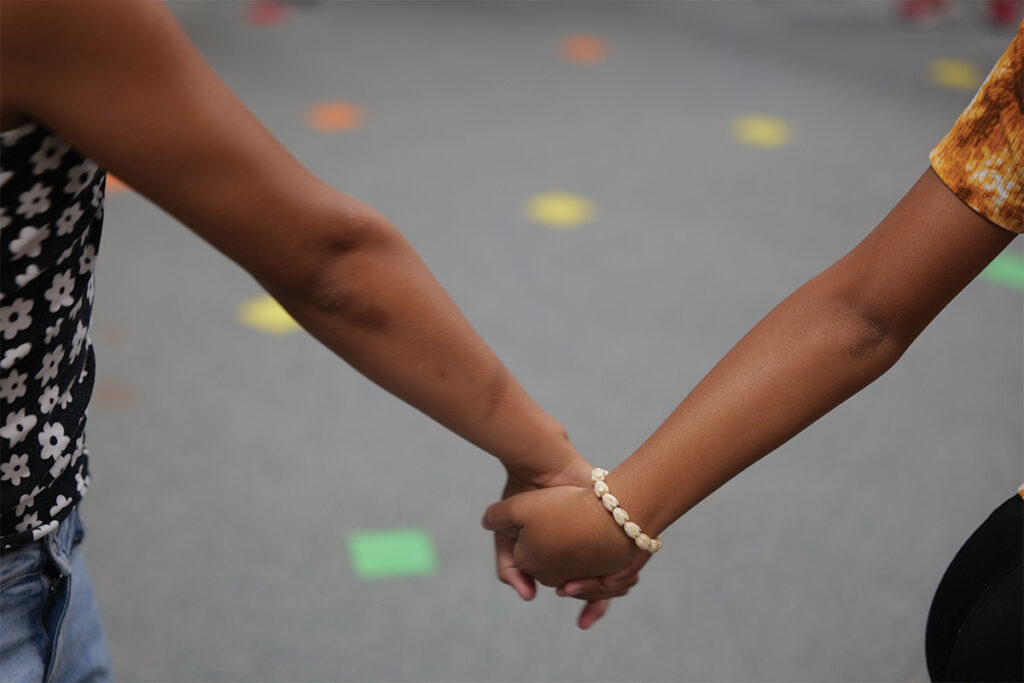Our Hawaiʻi public schools believe every student deserves a safe, respectful learning environment—both in school and online. Bullying, in any form, undermines the well-being and success of students. That’s why we are committed to empowering students, families and communities with tools and resources to prevent and address bullying. From proactive prevention programs to easy-to-use reporting tools like the Magsalita Ngayon HIDOE app, nakikipagtulungan kami sa aming mga komunidad upang itaguyod ang isang kultura ng paggalang, responsibilidad at empatiya. Sama-sama, masisiguro nating ang bawat mag-aaral ay nakadarama ng suporta at ligtas, upang sila ay umunlad sa akademiko at emosyonal.

What is Bullying?
Bullying is a serious issue that affects students of all ages and backgrounds. While there are many forms of bullying, we’ll be focusing on two primary categories: bullying at cyberbullying. Understanding these two types is important so we can all work together to create a safer and more respectful school environment.
“Bullying”—anumang nakasulat, berbal, graphic, o pisikal na kilos na nananakit, pumipinsala, humihiya o nananakot sa isang mag-aaral, kabilang ang mga may protektadong katayuan sa klase, na sapat na malubha, patuloy, o laganap na lumilikha ng nakakatakot, nagbabanta, o mapang-abusong kapaligiran sa edukasyon.
“Cyberbullying”—electronically transmitted acts, including but not limited to those transmitted through the Internet, cell phone, or other wireless hand-held device initiated by one student toward another student or employee of the department that hurts, harms, humiliates, or intimidates the student or employee; and is sufficiently severe, persistent or pervasive, that it creates an intimidating, threatening, or abusive educational environment. Cyberbullying can occur:
- Sa campus, o iba pang lugar ng departamento, sa transportasyon ng departamento, o sa panahon ng aktibidad o kaganapan na inisponsor ng departamento sa loob o labas ng ari-arian ng paaralan;
- Sa pamamagitan ng isang sistema ng data ng departamento na walang awtorisadong komunikasyon ng departamento; o
- Sa pamamagitan ng isang network ng computer sa labas ng campus, kung ang pag-uugali ay nakakaapekto sa kapaligiran ng edukasyon.
Additionally, cyberbullying may also be based on a person’s protected class, including but not limited to, a person’s race, color, religion, sex, sexual orientation, gender identity, gender expression, age, national origin, ancestry, disability, physical appearance and characteristics, and socio-economic status.
ReporT bullying with our App
HIDOE has an app that allows students to report bullying incidents. Our Magsalita Ngayon HIDOE Reporting App offers elementary, middle and high school students a way to report bullying incidents—digitally and anonymously, if they choose—that happen on campus, on HIDOE transportation, or at HIDOE-sponsored events.
- Panoorin ang mga video sa ibaba para sa sunud-sunod na pagpapakita kung paano magsumite ng tip gamit ang app.
- Magsalita Ngayon HIDOE Reporting App Flyer (PDF)
Paano Magsumite ng Tip
Mga Sekundaryang Mag-aaral sa Baitang 7-12
Mga Mag-aaral sa Elementarya sa Baitang 4-6
managing bullying
Bullying is a Community Issue
Bullying belongs to all of us. School staff can address incidents and support students at school, but they cannot stop bullying—in all its forms, and in all the places it occurs—on their own. Families, students, and communities have a role to play to adopt and promote a culture of respect, responsibility and resiliency.
Hinihimok namin ang mga pamilya na makipag-usap sa kanilang mga anak tungkol sa pagiging magalang at makiramay sa iba, kabilang ang mga iba sa kanilang sarili. Sa ating mga paaralan, nililinang natin ang mga katangiang ito bilang bahagi ng Nā Hopena Aʻo, social-emotional learning, and other efforts. While bullying can happen to anyone, students may also be targeted because of race, socio-economic status, sexual orientation, gender identity, learning disabilities and other qualities; a violation of mga batas sa karapatang sibil.
Community-wide strategies can help identify and support children who are bullied, redirect the behavior of children who bully, and change the attitudes of adults and youth who tolerate bullying behaviors in peer groups, schools, families and communities.
Any child who is bullied or who witnesses a bullying incident is encouraged to tell a trusted adult or report it using the Speak Now HIDOE app. If an incident happens on our school campuses, on HIDOE transportation, or during a HIDOE-sponsored event, appropriate school personnel will investigate.
Our Response to Bullying
- Pag-iwas: All schools are invested in building a positive school culture and climate to encourage all students to be respectful and empathetic. To address bullying behaviors schools may be implementing one or more of the following:
- Mga positibong gawi sa buong paaralan na nagtuturo sa mga mag-aaral na maging magalang, responsable at mahabagin na mga mag-aaral.
- Anti-Bullying Programs: Communities are unique, and schools have different approaches based on their community’s needs. Some schools have students leading their anti-bullying efforts.
- Mga Pakikipagsosyo sa Komunidad: Maraming mga paaralan ang naglilinang ng mga ugnayan sa mga ahensya ng komunidad, mga tagapagbigay ng kalusugan at kagalingan, mga grupo ng policing at community policing, mga legal na tagapayo, mga practitioner ng kultura at iba pa upang palawakin ang mga suporta.
- Tugon: Kapag may nangyaring insidente, ang punong-guro o ang kanyang itinalaga ay mag-iimbestiga sa:
- Tukuyin kung isang pagkakasala gaya ng tinukoy ng Hawaiʻi Administrative Rules (HAR) Kabanata 19 (PDF) naganap.
- Gumawa ng entry sa database ng suporta sa estudyante ng Departamento, na nagpapahintulot sa mga paaralan na tukuyin, subaybayan at subaybayan ang mga alalahanin ng mag-aaral sa paglipas ng panahon.
- Pagsubaybay: School staff provide supports to victims and bullies to address ongoing conditions that may have contributed to the bullying incident and to help prevent future incidents. These conditions may include issues at home, stress, abuse, and health, social-emotional and behavioral health issues, among others.
Maling pag-uugali at disiplina ng mag-aaral
Kabanata 19
Ang Hawaiʻi Administrative Rules, Kabanata 19, ay namamahala sa mga isyung nauugnay sa maling pag-uugali ng mag-aaral, which includes bullying, harassment and cyberbullying. It’s important that students and parents review this information to be aware of what constitutes a Chapter 19 violation, and what the consequences are.
I-download ang Hawaiʻi Administrative Rules, Kabanata 19:
- Espanyol (PDF)
- Tagalog (PDF)
- Thai (PDF)
- Tongan (PDF)
- Vietnamese (PDF)
Kabanata 19 Mga Isinalin na Liham ng Magulang
Kinikilala ng Departamento ang pangangailangan para sa mahahalagang liham na ito na isalin sa kanilang mga katutubong wika para masuri at ma-download ng ating mga pamilya. Kabilang sa mga ito ang:
- Kabanata 19 Liham ng Magulang
- Liham ng Magulang ng mga Baril
- Liham ng Magulang ng Electronic Smoking Device
- Ingles
- Hawaiian (paparating)
- Cebuano
- Chinese (Pinasimple)
- Chinese (Tradisyonal)
- Chuukese
Survey sa Pag-uugali sa Panganib ng Kabataan
Sinusubaybayan ng Youth Risk Behavior Survey (YRBS) ang isang malawak na hanay ng mga pag-uugaling nauugnay sa kalusugan sa mga mag-aaral sa sekondaryang paaralan, kabilang ang mga pag-uugaling may panganib sa kalusugan na nag-aambag sa hindi sinasadyang mga pinsala at karahasan; paggamit ng tabako; paggamit ng alkohol at iba pang droga; mga sekswal na pag-uugali na nauugnay sa hindi sinasadyang pagbubuntis at mga sakit na nakukuha sa pakikipagtalik; hindi malusog na pag-uugali sa pagkain; at pisikal na kawalan ng aktibidad. Ang YRBS ay pinangangasiwaan tuwing ibang taon kasabay ng isang pambansang pangangalap ng datos at pagsusumikap sa pagsusuri ng Mga Sentro para sa Pagkontrol at Pag-iwas sa Sakit. The Hawaiʻi YRBS is a joint effort of the Hawaiʻi State Departments of Education (HIDOE), Department of Health (DOH), and the University of Hawaiʻi’s Curriculum Research & Development Group. The Hawai’i YRBS data and reports are available on the Hawaiʻi Health Data Warehouse.
